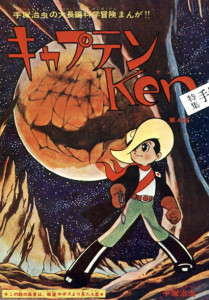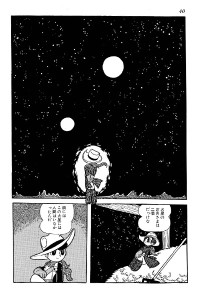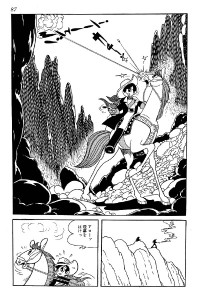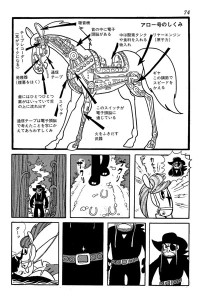Captain Ken (Manga)
Also known as キャプテン・ケン (Kyaputen Ken)
| English Title: | Captain Ken |
| In English? | Yes |
| Japanese Title: | キャプテン・ケン Kyaputen Ken |
| Type: | Ongoing Serial |
| Original run: | 1960/12/18 – 1961/08/20 |
| Published in: | Weekly Shonen Sunday 週刊少年サンデー |
| Published by: | Shogakukan |
| Volumes: | 2 MT-025 | MT-026 |
Following on the heels of the successful run of Zero Men (1959-60), Tezuka’s Captain Ken (1960-61) was serialized in Weekly Shonen Sunday from December 18, 1960 to August 20, 1961. Although Captain Ken (1960-61) is another of Tezuka’s explorations of the ability of sentient races to peacefully coexist, much like The Adventure of Rock (1952-54), Astro Boy (1952-68), and Zero Men (1959-60), it also shares a kinship with his gender-bending adventure, Princess Knight [Shojo Club] (1953-56).
What it’s about
In the future, mankind experiences something of a new age “gold rush” with humans rushing to settle on Mars… much to the chagrin of the native Martians. As expected, it doesn’t take long before the humans begin persecuting the Martians, quickly pushing them right to the brink of extinction. Amidst this turmoil, Mamoru Hoshino, the son of a local rancher, heads off to the spaceport to pick up his cousin, whom he’s never me, who has just arrived from Earth. Along the way, Mamoru is waylaid by a raiding party from the Martian Moro tribe and is aided by Captain Ken – a mysterious gunslinger with a fantastic robot horse who seems sympathetic to the Martian cause. With his robot horse having broken down, Mamoru returns home to find that his cousin, a lovely young lady named Kenn Minakami has already arrived – and who, despite being a girl, bears an uncanny resemblance to Captain Ken.
Captain Ken‘s sudden appearance in Hedes does not go unnoticed by the town’s crooked Mayor Deven, who has been using the conflict with the native Martians to line his own pockets with gold. After Captain Ken humiliates Mayor Deven‘s son, Double, who has been terrorizing the town as the leader of a band of hooligans, Deven enlists the aid of Lamp – a “black hat” sharpshooter, and one of only three people to have mastered “Martian-style shooting”, a technique of using Mars’ lower gravity in combat.
Soon Mamoru and Kenn are caught up trying to defend the Hoshino ranch from corrupt Earthlings and vengeful Martians alike. Meanwhile, Captain Ken is captured by the treasure-hungry Mayor Deven and sent to a Martian labour camp run by a cruel administrator who enjoys torturing Martians for sport. There he meets Papillon – a beautiful girl from the Moro tribe who has an amazing secret. With the assistance of the other Martian inmates, the pair escape and round up the crooks, but after handing them over to the authorities the direness to the Martian plight becomes readily apparent – the corruption goes all the way to the top. Not only is President Slurry in on the pillaging of the Martian treasures, he has a much bigger plan – to detonate a Solar Bomb that will exterminate the native Martians once and for all. Can Captain Ken and Mamoru stop the destruction? Just what is his mysterious connection to Kenn Minakami? Will he be able to master the Martian-style shooting technique and defeat Lamp in time? And just what does Papillon’s secret mean for their destiny together?
What you should know
Osamu Tezuka’s “Cowboys and Martians” tale, Captain Ken (1960-61), was the follow-up to a very successful run by Zero Men (1959-60) in Weekly Shonen Sunday. Although it didn’t quite match it in popularity, like its predecessor, it is another exploration of one of Tezuka’s favourite themes – the ability of two sentient races to peacefully coexist. In this case, pitting Martians against an ever-more exploitive and encroaching population of humans migrating from Earth. The set-up naturally parallels the early settlement of the American Old West, and Tezuka takes the cowboy visual right along with it – right down to laser-gunslingers and robotic horses.
Much like in his earlier work, The Adventure of Rock (1952-54), where he described the weather patterns and the food sources of his imaginary plant, Dimon, Tezuka’s descriptive details subtly, but greatly, enhances the narrative. In Captain Ken (1960-61), the Martian sky is violet rather than blue, the sun looks smaller and the pull of gravity is weaker than on Earth, and the Martians eat the peels and throw away the fruit.
It is also interesting to note that some of Tezuka’s personal views seem to be seeping through. According to sociologist Sakurai Tetsuo, as published in Osamu Tezuka Kodansha Gendaishinsho, the fact that the “hinomaru” (Japanese flag) was highlighted in Ken‘s costume, on a Mars where the rest of Earth’s national identities have been diluted in their depiction, is a reflection of Tezuka’s nationalism.
Captain Ken (1960-61) also demonstrates Tezuka’s sensitivity to his readership, and his ability to change something up on the fly. Originally the mystery of Captain Ken‘s identity was to be revealed as Kenn Minakami, but when sharp-eyed readers of Tezuka’s classic gender-bending manga, Princess Knight [Shojo Club] (1953-56) started sending in letters having spotted the girl-disguised-as-a-boy plot twist, Tezuka changed the punchline.
This was quickly followed up by a prize contest called “Guess Who Captain Ken Is!” that ran in Weekly Shonen Sunday. Out of the nearly 40,000 entries, only a handful of correct ones were received. In fact, according to Osamu Tezuka, in the afterword to the Osamu Tezuka Complete Manga Works edition (MT-026), “we received a huge pile of letters, but there were only two people who guessed correctly, and in my opinion they must have been truly brilliant. While 98% of respondents guessed that Captain Ken and Kenn Minakami were the same person, some guessed they were siblings, or that Captain Ken was actually a robot built to look like Kenn Minakami” (1978, p. 224).
However, it is interesting to note that, at the time, there were actually four winning entries announced in Weekly Shonen Sunday. The reason for the discrepancy lies in the fact that three of the four entries were received from people who (according to their mailing addresses) seemed to be from the same neighbourhood. This lead to the belief that they were acquainted with each other and had worked as a team to come up with the correct answer, and should therefore only be counted as one entry instead of three. So, officially, there were only two prize winners – one was the neighbourhood team, and the other, in perhaps a not-so-strange twist of fate, was a young man who later ended up becoming an animator at Mushi Productions.
Tezuka had originally planned on sending some of his personal sketch/note pages to the readers who had guess correctly, but never got around to doing it. So, in the end, the question of whether or not there were two or four contest winners, is a bit of a moot point.
Finally, Captain Ken (1960-61) is yet another example of Tezuka’s habit of going back and tinkering with his previous works. In this case Mamoru Hoshino‘s final words in the Weekly Shonen Sunday differ from those in the later collected editions because Tezuka felt the reveal that he was Ken‘s father was too subtle and unclear.
Where you can get it
In 2015, Captain Ken was published in English as a two-volume set by Digital Manga Publishing through the crowd-funding platform Kickstarter.






